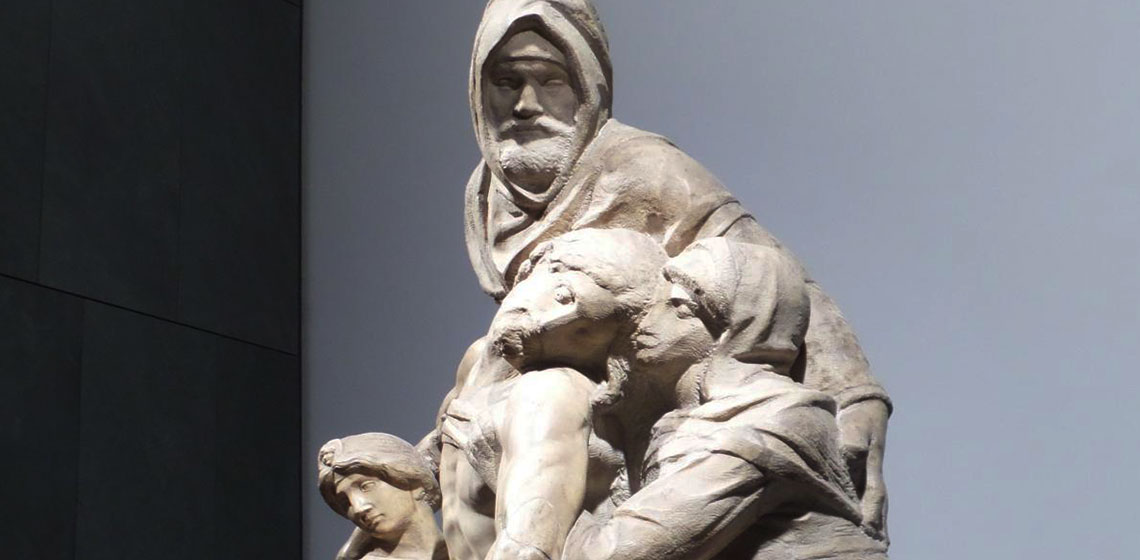
A journey through Michelangelo’s masterpieces
On the hunt for spots featuring the brilliant artist’s works.
Beyond the world-famous David, Michelangelo left Florence a number of works of unmatched beauty, immortal masterpieces that must be seen at least once in a lifetime.
If you’re aching to immerse yourself in Michelangelo’s genius world, you can follow a unique itinerary that takes you to the homes of his many works.
Need some help? Here’s a tour offering 5 different spots where you’ll discover Michelangelo’s lasting legacy.
All of the following locations can be visited with Firenzecard.
1. The Laurentian Library
Immerse yourself in centuries of history and culture in this extraordinary spot, a library housing invaluable manuscripts of every kind. Located in the heart of the San Lorenzo neighborhood, you’ll discover one of the most incredible architectural masterpieces built by the Florentine artist: he designed the entire structure and its interior spaces, including the decorations and furnishings.
The great staircase leading to the reading room, also called lo scalone, stands out as one of the space’s most incredible achievements and features a style that signals the approaching Baroque period.
Piazza San Lorenzo, 9.
Hours: open every day (excluding holidays):
Monday, Wednesday and Friday, 8:00am – 2:00pm;
Tuesday and Thursday, 8:00am – 5:30pm;
Closed Saturday and Sunday.
2. The New Sacristy
A short walk away, near the San Lorenzo Basilica, you can visit the splendid Medici Chapels.
Here, besides the crypt and the Chapel of the Princes, you can also admire one of Michelangelo’s most intriguing sculptural achievements. The New Sacristy houses the monumental tombs of members of the Medici family, vaunting their respective statues and the allegorical figures of day, night, dawn and dusk.
You’ll find yourself immersed in a place meant to signify the passage of time while somehow stopping it in its tracks: a tomb worthy of a royal family.
Piazza Madonna degli Aldobrandini, 6.
Hours: every day including holidays, 8:15am – 5:00pm.
Closed the first, third and fifth Monday of the month and the second and fourth Sunday of the month.
3. The Deposition
Want to discover one of Michelangelo’s most moving works and his (possible) self-portrait?
Then head over to the Opera del Duomo Museum, where you’ll find one of the last works created by the artist. In this marvelous artwork (despite its ‘unfinished’ technique), you’ll be amazed by the sense of humanity and compassion emerging from the sculpted figures; they’ll almost come to life before your eyes.
Piazza del Duomo 9.
Hours: every day including holidays, 9:00am – 7:00pm (opening hours are susceptible to changes due to extraordinary circumstances).
Closed the first Tuesday of the month.
4. Sculptures in the Bargello Museum
Nothing beats the Bargello Museum when it comes to admiring Michelangelo’s true artistry. Here, inside the Michelangelo and 16th-century sculpture hall, you’ll find some of his most beautiful works, including the Bacchus (an early work representing a rare pagan subject), the David-Apollo and the bust of Brutus (a possible celebration of the murder of Duke Alessandro de’ Medici by his cousin, Lorenzino, at the time interpreted as a liberation from tyrannical rule).
Via del Proconsolo 4.
Hours: open every day, 8:15am - 4:50pm.
5. The Doni Madonna at the Uffizi Gallery
Here, you can admire a revolutionary work displaying a common subject painted in an innovative manner: the Holy Family. In the painting’s composition, the distribution of space follows the logic of linear perspective, a feature that breaks from normal Renaissance criteria.
This work sets the tone for the artistic style that is to follow Michelangelo’s time, sparking a new kind of painting, that is, Mannerism.
Piazzale degli Uffizi, 6.
Hours: Tuesday to Sunday, 8:15am - 6:50pm.
Closed Monday.
Things to know!
There are many Florentine spots boasting traces of the great artist. Among these you’ll find the Casa Buonarroti, the family’s old residence that today houses a Michelangelo museum, the Santo Spirito Basilica, where you’ll find a wooden crucifix realized in his youth, and Palazzo Vecchio, where you’ll find the Genius of Victory, a sculpture originally created for Pope Julius II’s tomb.






 All the services are provided by local merchants
All the services are provided by local merchants By using this site you support Florence
By using this site you support Florence We offer products with high-quality standards
We offer products with high-quality standards You stay sustainable
You stay sustainable It's a 100% trustworthy website
It's a 100% trustworthy website